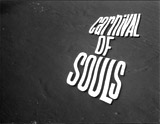
|
Carnival of Souls (1962)
In producer/director Herk Harvey's (his sole feature
film) disturbing, low-budget independent horror film, the spooky
and haunting cult zombie classic was notable for its many effective
and foreboding scenes of stylistic terror. It masterfully portrayed
the psychological despair and loneliness of a lost young woman who
then began to have visions of a ghostly netherworld. A story written
by both Harvey and his script-writer John Clifford resulted in the film.
It has been acknowledged by George A. Romero that this
film inspired the first of his "Dead" series of zombie
films - Night
of the Living Dead (1968). In homage to the film, it was
remade by director Adam Grossman and was originally titled
Wes Craven Presents Carnival of Souls (1998).
The plot of the macabre B-movie, often
praised for Maurice Prather's atmospheric cinematography, was very
similar to the late January, 1960 30-minute TV episode of The
Twilight Zone titled "The Hitch-Hiker" (with Inger
Stevens), and also to the short French film Occurrence
at Owl Creek Bridge (1961). Its plot twist resembled many other
films about death-dreams ("It was all a dream")
and/or hallucinatory fantasies at the point of death (or in purgatory).
With a budget of only $33,000 dollars and shot in three
weeks time on location in Kansas and Utah, this early amateurish
horror-zombie-mystery film took years to gain a solid cult audience
(through midnight and drive-in showings, and late-night TV broadcasts).
The film was re-released and re-evaluated by the late 1980s with
the release of a restored version in 1989 and film-festival and theatrical
showings, and further DVD releases in the 2000s.
- in the film's opening sequence set in rural Kansas,
young Mary Henry (Candace Hilligoss in her film debut) with her two girlfriends
(Sharon Scoville and Mary Ann Harris) were goaded by a male drag
racer (Larry Sneegas) and his buddy into a speed race along winding
back country roads
- the contest resulted in the car (holding three females
in the car's front seat) crashing off a bridge into a muddy river
and landing upside down; as the males looked down at the
car in the water, the
text of the title screen floated in and out and rippled, followed
by further slanted and disoriented credits shown over the background
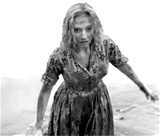
|
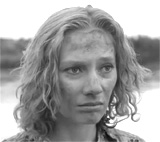
|
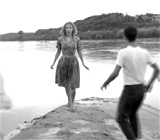
|
|
Mary's Imagined Survival (Spoiler)
|
- a search party was organized to locate
the submerged car but failed to find anything after three hours,
and it was presumed that all three occupants of the car had drowned;
but then mysteriously, the barefoot, bedraggled and very muddy
Mary emerged unscathed and unharmed from the water (but didn't
appear wet) and climbed up a sandy embankment; it
appeared that she was the sole crash survivor (?); however, she
was very disoriented and unable to answer
questions after the horrific car accident
- as the story progressed after her near-fatal
incident, Mary demonstrated her playing
skill on a gigantic pipe organ as the organ factory boss (Tom
McGinnis), a carpenter (Forbes Caldwell) and others listened; she
learned that an organ made in the factory had been acquired
by a church in the Salt Lake City area of Utah that was looking
for a new church organist; Mary had already inquired about
employment, and was planning to relocate, but told the boss
that she wasn't religious: "It's just a job for me"; he offered
some words of advice: "It takes more than intellect to be a
musician. Put your soul into it a little, okay?"; she vowed:
"I'm never coming back"
- she took one last drive over the bridge where
the accident happened before leaving town; while on the trip,
Mary listened to a music station, but as she crossed into Utah and it turned dark, she scanned
her radio dial and was only able to tune into ominous and unsettling
organ music (by composer Gene Moore) that apparently wasn't
from the air waves but was playing in her head
- she experienced one of
many weird, disturbing, and creepy visions of a ghostly figure
(a recently dead zombie?); a ghoulish Spectral Man (director
Harvey) with darkened eye sockets and a deathly pale face first
glared at her with an eerie stare through the passenger window;
she also viewed him through her front windshield standing in
the middle of the road; the shocking sight of him caused her to veer
off the road; however, she was still able to proceed onward
- after stopping for gas in the twilight hours,
Mary asked the attendant (Dan Palmquist) about a lakeside structure
she had noticed a few miles away; he told her about the
history of the "pretty ritzy
place in the old days"; now, it was an abandoned, condemned,
and closed-down salt-water bathhouse and Pavilion dance hall
that had also become a carnival-amusement park at one time
[Note: The Pavilion was in Salt Lake City's Saltair Amusement
Park first built in 1893 on the southern shore of the Great
Salt Lake, and rebuilt multiple times due to fire. The spooky
locale was often abandoned due to the receding lake and changing
economic conditions and tastes.]
- as he pointed out into the darkness, the scene
transitioned to her entry into an apartment in a rooming
house in town; she had paid a week's rent to a pleasant
landlady Mrs. Thomas (Frances Feist); there was only one other
tenant across the hall - John Linden (Sidney Berger); as Mary
unpacked her suitcase, she caught another brief glimpse of
the Spectral Man stalking her outside her window, but then
the figure disappeared
- the next day, she visited a local church to
inquire about the job opening she had already heard about;
she spoke to the Minister (Art Ellison) about
becoming their new church organist; as she played the organ
(for practice) located in the rear balcony of the church, the
Spectral Man entered the downstairs rear of the church and
looked up; afterwards, she accepted a ride from the Minister
who suggested that she stop and look at the lakeside Pavilion,
but once they were there, he warned her to not enter through
the barrier fence; the area was gated and off-limits, and he
warned that it was unsafe and entry would risk breaking the
law by trespassing
- Mary returned back to the rooming house, where
she was interrupted while taking a bath by her neighbor John
Linden (Sidney Berger); he revealed his creepy personality
by spying on her after her bath, and by being pushy and aggressively
asking her out for dinner, and commenting upon how lonesome
her room looked; she rejected his unwanted advances
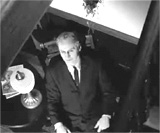
|
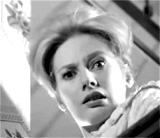
|
|
The Spectral Man at the Bottom
of the Rooming House Stairway
|
- in the hallway, Mary was spooked when she saw
the pale-faced Spectral Man in the foyer at the bottom of the
rooming house's stairway, stalking her again; after she reported
the figure to the landlady who brought her coffee and a sandwich,
Mrs. Thomas claimed that Mary must have been envisioning
things in the old and "creaky" house and that it
was all in her imagination: ("There is no other. Me and
you and Mr. Linden"); later that evening in bed (with
organ music on the soundtrack), Mary feared being alone with
lightning crackling and thunder booming; as she stood by her
window, her thoughts were directed back toward the Pavilion
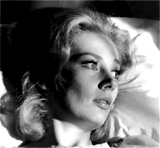
|
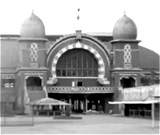
|
|
Mary Spooked at Night, With Thoughts of the Pavilion
|
- the next day early in the morning, she was again
pestered by John Linden who brought coffee and two cups into
her room; Mary explained her new job as a professional church
organist but that she wasn't necessarily a "church woman";
she also shared that she had the "strangest feeling" during
the previous dark and "lost night": ("In the dark, your fantasies
get so out of hand"); after getting-to-know-each-other conversation
and claiming he was a "happy" warehouse worker, he suggested
more time later with her: ("You're gonna need me in the evenin'
too. You just don't know it yet")
- during a visit to a department store in town
to buy a dress from a saleslady (Pamela Ballard), after trying
on some dresses, Mary experienced a moment in the dressing
room when she became disconnected, withdrawn and detached from
reality; she tried speaking to the saleslady but was entirely
ignored; she asked herself: "What's the matter with everyone?
Why don't they answer me?"; she was invisible and inaudible
to others in the store and seemed to be caught between the
real world and a dream-world
- outside the store on the sidewalk, she also
seemed to be unnoticed and she couldn't hear sounds; but then
under a tree in a nearby park, she began to hear birds chirping
and other sounds of city life; Mary was relieved that things
seemed to be normal again; however, as she leaned down at a
drinking fountain, a black-suited man approached
and scared her away; frightened, she told another bystander
that a strange man had been following her: "It was that man.
That man! There was someone else there! That strange man was
there!" - but the man at the fountain wasn't the
ghoulish, black-suited apparition she had been envisioning
or hallucinating about earlier; the 2nd bystander, who identified
himself as a physician, held onto Mary and urged her: "Hysteria
won't solve anything. Now control yourself...You've had a shock.
If you would like my assistance, I'll be glad to offer it"
- during an office consultation (across the street)
with the physician who identified himself as Dr. Samuels (Stan
Levitt), Mary explained what had happened in the dress-shop:
("It was more than just not being able to hear anything,
or make contact with anyone. It was as though, as though
for a time I didn't exist. As though I had no place in the
world, no part of the life around me"; he
suggested that her hysterical fears or worries were possibly
a result of her recent car-crash trauma and injury - ("a serious
emotional shock"), and could just be in her imagination:
("Our imaginations play tricks on us. They often misinterpret
what we see and hear"); Mary admitted that she didn't care
for "the close company of other people...I don't seem capable
of being very close to people"; Dr. Samuels confessed that
he wasn't a psychiatrist but still wanted to attempt to figure
out her mental state; it was possible that the black-suited
man was symbolic of a "guilt feeling" that she had
- the strong-willed Mary
suspected that her persistent visions of the dark figure tracking
her might be associated with the strange but deserted Pavilion
outside of town; she hastily proposed returning there to confront
her fears, but upon visiting, she found nothing unusual, although
it was eerily vacant and spooky
- during organ practice in the church in the early
evening as she played a traditional hymn, she suddenly found
herself compelled to play an eerie musical piece; trance-like,
she also experienced more visions of the man (with darkened
eye sockets) and other similar-looking souls rising up from
under the water, and then twirling around as they danced in
the Pavilion; as the Spectral Man left the dancers and approached
Mary to strangle her, she realized that the Minister's hands
had grabbed her hands as she was playing the organ; he was
so appalled by her offensive music selection (calling it "profane"
and a "sacrilege") that he forced her to resign
her job: ("I'm afraid you cannot be our organist"
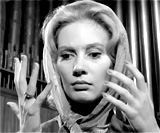
|
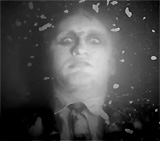
|
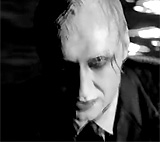
|
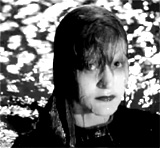
|

|
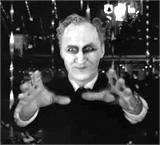
|
|
Mary's Hands Uncontrollably Playing
Eerie Organ Music in the Church, Accompanied by Visions of
Frightening 'Dead People' In the Pavilion
|
- having lost her job and scared of being alone,
Mary found her sleazy neighboring lodger John waiting for
her outside the church; he insisted on taking her to a
nightclub and bar for the evening, and was upset that she didn't
like the loud dance music or the drinking; once
back in her room, he drunkenly pressured her to be with him,
but she rejected his crude and unwanted assaultive attacks;
Mary experienced another phantom vision of the ghoulish man
reflected in her dresser's large mirror; she became crazed
and hysterical, and scared John off thinking that she was possessed
(he called her "some girl who's off her rocker")
- for the remainder of the night, the insanely-behaving Mary rearranged
her room's furniture to block all entry points, causing her baffled
and worried landlady Mrs. Thomas to share her worries with
Dr. Samuels the next morning; the landlady watched as Mary
vacated her room with her luggage, and advised her that she
wouldn't be refunded any of her pre-paid rent
- Mary drove off to leave town, but immediately experienced
transmission problems with her car; she drove into a gas station
in town for repairs, where she insisted on remaining in
the car as it was hoisted up in the air on a hydraulic lift;
in the film's sole "dream-within-a-dream" sequence, while the attendant
took care of a gas customer, she dozed off; she heard footsteps
and hurriedly locked all the doors; as she leaned against the
passenger door, it opened and she fell out - but the car had
already been mysteriously lowered back down in the dark
garage by "the Man"; she ran off down the street and frantically entered
a bus station; she again felt invisible
and couldn't hear any sounds in her quasi-parallel universe; the
ticket attendant and others didn't hear or notice her when
she asked for directions and inquired about bus information
- she ran onto an eastbound departing Greyhound
bus from Gate 9 that was loudly announced by a monotone voice
on the PA system, but was horrified that the occupants on the
bus - the same otherworldly apparitions that she had seen dancing
in the Pavilion during organ practice - grabbed at her and
chased after her (to the accompaniment of non-stop organ music);
she couldn't get the attention of a motorcycle cop or a taxi-cab
driver; she cried out: "Why can't anybody hear me?"
- Mary returned to the park that she had visited
earlier after shopping for dresses, and was relieved that things
again appeared normal; she returned to
Dr. Samuel's office, but screamed in reaction when the doctor
- actually the black-suited "Man" with
his back to her - swiveled his high-backed chair around to reveal
himself; it was then suddenly shown that Mary actually awakened
in fright and was still sitting in the car on the garage station's
lift (it had been lowered) - and everything had been a nightmarish day-dream
- she pulled out of the station and was inexorably drawn to drive toward the
Pavilion; at this point in the story, she
was lured to enter into the shadowy Pavilion's ballroom during
a macabre party; she again envisioned ghoulish souls rising up
in the salty water; and then inside the decaying
dance hall, the lights turned on and she again saw
a surreal "dance of death" performed by zombie-like
ghouls or souls (a "carnival of souls") that she had
already seen in her visions and on the bus; the dead spirits
were twirling around as dance partners; Mary
literally entered into the world of the dead;
Mary realized that her actual dead doppelganger or
double was dancing with the ghoulish Spectral Man
|
Mary After Having Returned to the Pavilion -
She Warily Watched 'Dance of Death' Couples (Including Her
Own Dead Doppelganger) Inside The Abandoned Ballroom
|
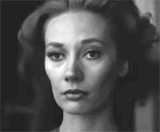
|

|
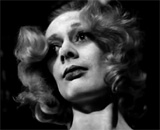
|

|
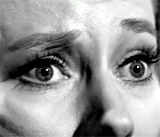
|
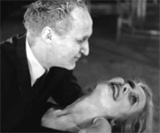
|
- she screamed in fright and
ran off - as the camera motion
was sped up while the soundtrack was distorted with laughter;
she was chased by many of the undead, dark-eyed dancing partners
all around the Pavilion and then to the beach, where she fell
down in the sand during the pursuit - her collapsed body was
completely surrounded by the heads of the zombies staring down
upon her as the screen darkened
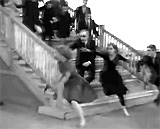
|
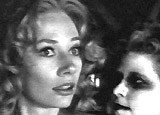
|
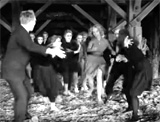
|
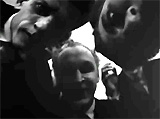
|
|
Mary Chased and Pursued Outside the Pavilion by
Ghoulish Dancers - She Collapsed on the Beach Sand - Surrounded
by Zombie Heads Staring Down on Her From Above
|
- the next day at the Pavilion, Dr. Samuels, the Minister,
and the Sheriff went searching for Mary who had mysteriously vanished; the
search party surveyed the sand where Mary had fallen, with tracks
of footprints in the sand leading up to where she had collapsed
- with a large imprint of her body and an opened handprint; however,
there was no sign of Mary's body; the Sheriff
announced how Mary's car had been found at the Pavilion's gates
nearby: (Sheriff: "Her car's still over there, and then there
are footprints leading up to here. And then nothing")
[Note: This scene was the most incongruous one in the film
- if her body was examined in Utah, how could it also show up in
the last and final scene back in Kansas?]
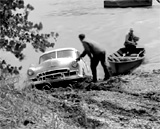
Car Dredged Up
|
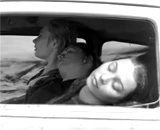
Twist-Ending: Mary's Corpse in Dredged-Out Car
|
- in the revelatory final scene's plot twist, back in
Kansas, a man in a search boat called out to a tow-truck driver:
"The car is right down there. Bring it on up"; he
had recovered Mary's submerged car (with Mary's corpse inside along
with her two friends in the front seat) - it was partially dredged
out of the river; Mary's dreams, imagined visions and trances involving
the ghouls in a dance of death were due to her hallucinations during
her death experience and entry into the spirit world
|

Three Girlfriends in Car Challenged to Drag Race

Drag Racing Along Country Road

The Deadly Crash Off a Bridge

Mary's Organ Playing in a Kansas Organ Factory

Mary Glancing to Her Right in Her Car - An Ominous Figure

The Spectral Man Seen Through Mary's Front Windshield

Mary Speaking to the Town's Minister (Art Ellison)

The Spectral Man In the Rear of the Church as Mary Played the Organ
in the Balcony

The Minister and Mary at the Barrier-Fence Surrounding the Pavilion
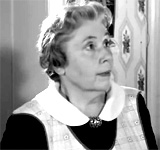
Mary's Landlady Mrs. Thomas (Frances Feist)

Aggravating Tenant Neighbor Mr. Linden (Sidney Berger)
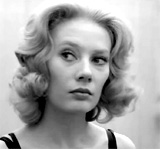
Mary's Confusion and Withdrawal From Reality in the Dress Shop
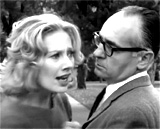
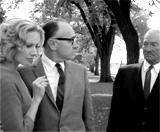
Mary's Fright at the Park's Drinking Fountain with a Physician (Dr.
Samuels) and Another Black-Suited Bystander
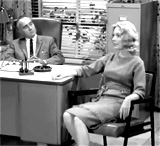
Mary Discussing Her Black-Suited Man's Vision to Dr. Samuels in His
Office
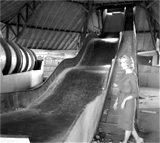
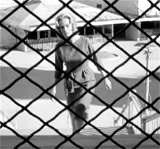
Mary's Return Visit to the Pavilion
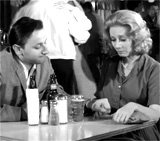
Awkward Date with Neighbor John
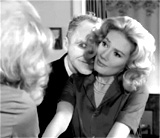
Upsetting Hallucination of the Spectral Man In Her Mirror
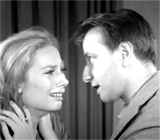
Mary Acting Crazed, Causing John to Think She Was "Off Her Rocker"
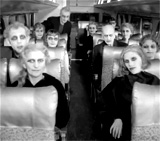
Dream Within a Dream: Passengers on Bus at Gate 9
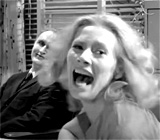
Dream Within a Dream: The "Man" Seated in Dr. Samuel's Chair


More of Mary's Visions of "The Man" and Ghoulish Souls Rising
Ominously From Beneath the Salty Lake

Mary Screaming in Horror at the Sight of Her Own Undead Dancing Self Inside
the Pavilion
|


























